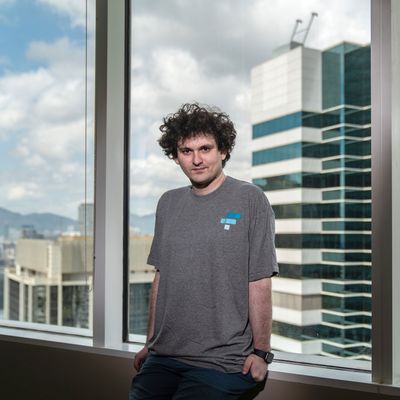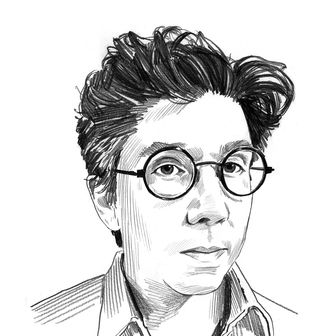
The meeting is already Silicon Valley lore. When Sam Bankman-Fried met with the venture capitalists at Sequoia Capital, the legendary firm that funded Apple, Google, and Instagram, he wasn’t there so much to talk about the technology of his crypto exchange, FTX, or about his hedge fund, Alameda Research. What he talked about was bananas — the actual yellow fruit. “I want FTX to be a place where you can do anything you want with your next dollar. You can buy bitcoin. You can send money in whatever currency to any friend anywhere in the world. You can buy a banana. You can do anything you want with your money from inside FTX,” he said, according to Sequoia’s own account of the meeting. It was exactly the kind of big idea that Silicon Valley loved, but that wasn’t what made the VCs go nuts. “It turns out that that fucker was playing League of Legends through the entire meeting,” Ramnik Arora, FTX’s former head of product, told the VC firm in their promotional write-up of the meeting. “We were incredibly impressed,” another funder said. “It was one of those your-hair-is-blown-back type of meetings.”
Now, the game is over for Bankman-Fried. Just weeks ago, he was a Democratic megadonor, one of the richest men who ever lived, the very face of what many in Washington and on Wall Street thought was the future of the economy: someone who could unlock the potential of cryptocurrencies and still walk with ease through the traditional world of money and power. In less than a week, it was all annihilated, with questions of fraud and admissions of misappropriating his own customer’ funds exposing his empire to be a house of cards. On Friday, FTX and his hedge fund, Alameda Research, filed for bankruptcy, and he resigned as CEO of the exchange. Government officials in the Bahamas, where his companies are based, seized what was left of their assets. Investigators are reportedly probing his company and him, personally, to understand what happened — investigations that are likely to delve into whether or not the former wunderkind (an MIT physics major whose parents are both Stanford professors) defrauded his way into the most rarefied of positions. Sequoia, like other VCs who plowed money into the company, proactively marked down their stake to zero. “I don’t want to call it fraud in this moment,” Anthony Scaramucci, the ex-Trump adviser who sold part of his investment business to Bankman-Fried, said on CNBC Friday. “If there was fraud, let’s clean it up to the extent possible and repair the accounts at FTX.”
Now, just like his companies, Bankman-Fried’s complex and shadowy life is unraveling. He was reportedly in a kind of polycule with his ten other roommates in the Bahamas, who were apparently not only romantically involved with each other but also were de facto running his empire. His association with “effective altruism” has tarnished the movement, and the entire team behind his philanthropic organization has quit. (Bankman-Fried cultivated a wave of glowing media coverage earlier this year by pledging to give away his massive fortune.) Twitter has been alight with crypto investors, and even the CEO of the investment bank Jefferies, sharing stories about “reckless” actions by Bankman-Fried. The millions he spent helping elect Democrats and write his own regulatory agenda in Washington have blown up, effectively turning him — and the crypto industry — toxic.
Bankman-Fried’s reputation as a gamer — where the line between what’s real and what’s sport — has now come to define him. Since FTX collapsed, fake screenshots of his player profile on League of Legends have made the rounds with false rumors that he was playing the game after announcing that he was going to sell his exchange to his biggest rival — a deal that ended up collapsing the next day. Even if it wasn’t true, the bigger problem for Bankman-Fried was that it was plausible. The company’s chief regulatory officer was involved in a poker cheating scandal years ago. He was an investor in Axie Infinity, a crypto game that collapsed after gamers found it exploitative, and Stepn, a “walk to earn” app that ended up funneling money away from users in the form of NFTs and transfer fees. This was a guy who, despite the patina of respectability he gave to the crypto industry, thrived on the kinds of risks one takes when it’s all a game — and wasn’t known for doing the kind of boring, necessary work that keeps complex financial institutions from collapsing. “This guy knew his shit,” said William Quigley, a co-founder of Tether who had a meeting with him and a politician in June to talk about the crypto industry. “But I have my own view of what happened. Young people tend to whistle past the graveyard. They think of risk controls as boring stuff that should be set aside.”
The fall of Bankman-Fried and his crypto empire marks an early capstone to the worst year in crypto’s 13-year existence. For anyone paying attention, it seemed inevitable. Spend enough time in crypto circles and the presence of literal teenage millionaires is off-putting, and those who have some kind of pedigree — people who came from, say, Goldman Sachs or a big tech company like Facebook — try weirdly hard to sell you on the next big thing. There was always the sense that, because crypto was entirely digital, everyone in the industry was creating a whole new world. Last November, when the crypto markets reached their peak of more than $3 trillion globally, staunch believers in the transformative power of crypto told me that the bubble was nearing a burst and they were only waiting for Washington to come in and end the wildest party of their lives. In 2022, it all happened. It was only a few months ago that $60 billion was wiped out of the industry when Do Kwon, who had styled himself as the second coming of the pseudonymous bitcoin creator Satoshi Nakamoto, oversaw the collapse of one of the world’s largest crypto companies and then went on the lam. (South Korean prosecutors believe he’s hiding somewhere in Europe now.) The contagion from that fallout led to real destruction, creating a new graveyard of ignominy littered with the names of companies that had been approaching something of a blue-chip status for the new industry: the lenders Voyager and Celsius, the hedge fund Three Arrows Capital.
Bankman-Fried was supposed to be the antidote. This was the MIT math whiz, the guy who made money at a known hedge fund, Jane Capital, through the perfectly normal practice of trading arbitrage — buying crypto where it was cheap, selling where it was expensive, and then pocketing the difference. Yes, he looked kind of silly with his mop of hair and T-shirts and running shoes, regardless of the situation — but he was the one sitting up on stage with Bill Clinton and Gisele Bündchen. Dressing like crap while sitting next to a former president or the world’s most famous model was the kind of power move that Aaron Sorkin wishes he could have come up with. It contributed to his lore. One person who worked with him at Jane told me he was known to be a kind of brilliant weirdo, and his walking around the office in socks was tolerated because he made so much money. In the wake of the collapse of Do Kwon and Three Arrows earlier this year, Bankman-Fried positioned himself as the buyer of last resort, swooping in to save crypto banks Voyager and Celsius and lending $400 million to save another exchange, BlockFi. (Fortune magazine’s now-notorious cover story on him, calling him “The Next Warren Buffett,” made a little more sense at the time when the young billionaire was aping the Berkshire Hathaway chairman’s investment strategies.) He also went on to plow money into Robinhood, the meme-stock broker, IEX, the stock exchange made famous by Michael Lewis, and other less-flashy financial infrastructure businesses.
Despite all the technospeak around crypto, what happened here was an old-fashioned bank run, the same variety of phenomena that happened in the Great Depression or the collapse of Lehman Brothers. While FTX was positioned as a platform for safely and quickly trading cryptocurrencies — essentially a New York Stock Exchange for this industry — what wasn’t known was that it had a secret funding relationship with Bankman-Fried’s other main business, the hedge fund Alameda. As a way to fund FTX’s operations, it issued its own cryptocurrency called FTT — similar to what a traditional company would do by selling stock or bonds. That all collapsed spectacularly starting this month when CoinDesk published some of Alameda’s internal holdings showing that Alameda was by far the biggest holder of FTT. Alameda was known for taking big, leveraged bets on crypto companies —stoking fears, which turned out to be true, that it didn’t have enough money to cover its debts. This raised all sorts of alarm bells, particularly around the amount of capital that FTX had to pay back its customers.
One person that took particular notice of Alameda’s leaked balance sheet was Changpeng Zhou, the owner of rival crypto exchange Binance. Known as CZ, he was an early investor in FTX but had cashed his stake out last year in exchange for about $2 billion in crypto — including about $500 million in FTT tokens. After the CoinDesk story, CZ announced that he was going to dump Binance’s FTT holdings. Caroline Ellison, the then-CEO of Alameda, publicly offered to buy the tokens at $22, below where they were trading. To announce a price like that publicly was about the worst move anyone could make on Wall Street since it seemed to signal the point where things would combust. “That really raised a bunch of questions. Why did she stipulate the price? The rumor was, Oh, they just have pledged FTT tokens, and below 22 was the margin call,” Quigley said. (Translation: If FTT fell below that price, Alameda would be in big trouble since it was their largest holding and they also had a lot of debt.) That weekend, Bankman-Fried said, about $5 billion was sucked out of FTX as panicked depositors withdrew their money. With the value of the FTT tokens in free fall, they couldn’t sell enough of their FTT tokens to pay everyone back. “That’s when the assets shrunk below the liabilities in the balance sheet,” Quigley said.
According to Bankman-Fried’s own tweets, the money that propped up those tokens in the first place was customer deposits. He blamed it on “a poor internal labeling of bank-related accounts” — essentially saying that a labeling error had persisted for months at a time and no one inside FTX had noticed the problem. It’s a baffling assertion considering that even the smallest banks and hedge funds have back offices dedicated to making sure that money that shouldn’t get commingled doesn’t. Even some of the most notorious figures on Wall Street were shocked at the details coming out of SBF’s crumbling empire. “This is going to really hurt crypto quite a lot,” said Martin Shkreli in a Discord chat hosted by the anonymous Twitter account Autism Capital, which has been publishing real-time information about the collapse of Bankman-Fried’s empire. “But I think he’s going to end up being the sacrificial lamb because you’ve had a lot of bad crypto actors over the years. We saw this with Enron and WorldCom and Bernie Madoff, where you have a bunch of bad actors, and then one person really gets nailed to the wall to get crucified for all the bad actors.”
It’s not clear what’s going to happen with FTX or the people whose money is trapped on the platform. The repercussions are likely to be even deeper than the Terra blowup earlier this year, with companies he was about to rescue now likely out of luck. The company had apparently been expanding in sub-Saharan Africa, where bank access and resources that could help people get their money back are spotty. Bankman-Fried has repeatedly apologized on Twitter. Ryne Miller, a lawyer for FTX who reportedly pushed back against its internal practices, didn’t want to talk when I reached him by phone and referred me to a press release. Bankman-Fried hasn’t really offered a convincing story of how it all collapsed so quickly, though what has emerged has been damning. Still, it’s not clear that Bankman-Fried views this as anything more than a game that was to be won or lost. On Thursday, after FTX collapsed and while he was still a CEO in the midst of searching for emergency capital, Bankman-Fried posted a thread laying out his perspective on the last few days. Buried in the 20th tweet was an oblique reference to CZ. Just a few days before, when Zhao had mulled buying FTX, Bankman-Fried thanked him, saying he was excited to work with him and that it was all in good hands. But now, the businessman was something else: just another “sparring partner” — this time, someone who got the best of him.






























